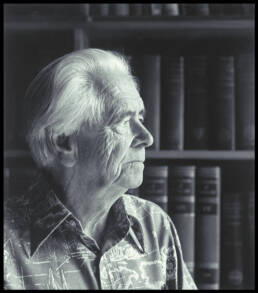These life stories may contain descriptions of childhood trauma and abuse, as well as images, voices and names of people now deceased. If you need help, you can find contact details for some relevant support services on our support page.
Iconic Australian Bernard Smith (1916-2011) was in foster care from the time he was a tiny baby. He went on to become an academic, art historian, art critic and prolific writer (he published more than twenty books) at a time when boys in state care were expected to become labourers.
Smith has the status of “the father of Australian art history” because of his championing of Australian art, but his influence extends far beyond art. According to Smith’s biographer, Sheridan Palmer, “anthropologists, ethnologists and cultural theorists have all claimed him as a ‘giant’ in their fields” too.
Bennie, as Smith was known when he was little, was born in 1916 in Balmain, NSW, to Rose Ann Tierney, a twenty-six-year-old unmarried, recent migrant to Australia from poverty-stricken Ireland.
Rose Ann worked as a domestic servant, the principal source of employment for working-class women at the time. She tried desperately to support her baby with only minimal and sporadic financial assistance from Bennie’s father, nearly sixty-year-old Charlie Smith. To keep her job, Rose Ann paid other women to care for Bennie and this eventually led her to Tottie Keen, a foster carer living in the Sydney suburb of Burwood.
‘Mum Keen’, as Smith lovingly called his foster mother, gave up domestic service to take in children for the NSW state, although she initially made a private arrangement with Rose Ann. Rose Ann visited Bennie regularly for several years, but when she went to Queensland in search of better pay and contact with her brothers, ‘Mum Keen’ organised for Bennie to become a ward of the state.
Smith’s experience of foster care was primarily positive. He was adored by ‘Mum Keen’ who wanted him to get enough education to have a white-collar job and who encouraged him to stay in contact with Rose Ann.
However, Bennie was also well aware of his low status as ‘illegitimate’ and a ward of the state. He was taunted and bullied at school and survived by developing what he called a “wild scraggy appearance”, by becoming a “real little toughie” (Smith, 132). He decided at a young age he was not going to be a “server” in a society of served and servers (Smith, 140).
Inspiring teachers at Enmore High—a high school which existed for only two years for boys trying to improve their job prospects during the Great Depression—and access to the Sydney Municipal Lending Library enabled Bennie to receive a two-year scholarship to Sydney Teachers College where he took Art as his specialty.
Smith taught in a small country school, and then attended the University of Sydney in 1946 at the age of twenty-nine. He had already published his first book, Place, Taste, and Tradition in 1945.
In 1948 Smith was granted a British Council scholarship to study at the University of London. Publications from that work led to his first academic appointment at the University of Melbourne in 1956; he had completed his PhD at Australian National University in 1952.
References:
Palmer, Sheridan. “Bernard Smith 1916-2011.” Australian and New Zealand Journal of Art, vol. 12, no. 1 (2012):16-23.
Smith, Bernard. The Boy Adeodatus. The portrait of a lucky young bastard. Ringwood, Vic: Penguin.
Image available here.
